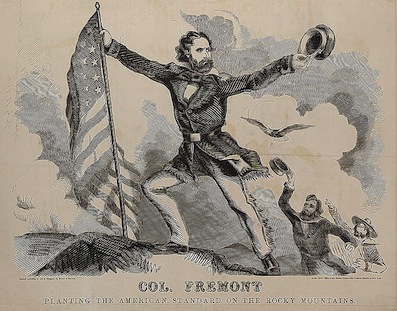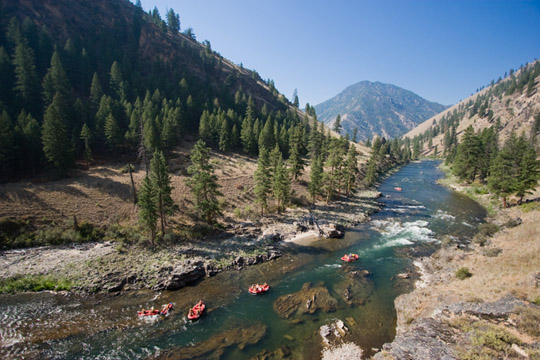The Origins of Whitewater Rafting in the West
Nick Bowman, December 14 2012
It can be said that white water rafting is as old as rivers, and that men have sought thrills since there were waters to ride. The history of white water rafting as we know it begins very far in the past. It is from the ancient traditions of the Nez Perce and other tribes of Oregon and Idaho that the modern sport of white water rafting was derived. From those origins it has become a popular outdoor activity in many western states, featuring organized tours as well as intrepid groups of (hopefully) experienced individuals.
The Nez Perce and the early days of white water navigation
Oregon sits on the Columbia River while Idaho contains much of the Snake River -- a tributary of that watershed. Both of these rivers have a very strong current (and one which used to be much stronger before structures such as the Bonneville and Dalles Dams were built). Because this river system is fed from the heights of the Rocky Mountains, it loses elevation very quickly, and it is the speed of its flow which creates the famous and sometimes challenging rapids for which it is renowned.
The Colombia River and its tributaries were the main livelihood of many native tribes for almost 15,000 years. The names of these tribes are familiar to any student or resident of the American West. They include the:
- Colville
- Spokane
- Coeur d'Alene
- Yakama
- Nez Perce
- Cayuse
- Palus
- Umatilla
- Cowlitz
- Warm Springs
All of these tribes called the Colombia River system their home. Along the Columbia's largest tributary, the Snake River, lived the Nez Perce and the Shoshone tribes. Because the Nez Perce relied (and still rely) on fishing for their food, they learned to float upon and navigate the Snake River. That knowledge was later passed down to Lewis and Clark, who were given boats and guides by the Nez Perce.
River rafts and expeditions in the early United States
The early history of the United States saw many different types of river rafts from simple to complex. American rafts began with the pirogue, or flat-bottom boat. There were a variety of pirogue designs, and from the pirogue developed several other different types of rafts. Another boat called the bateau originated in the East but also spread to the West. The bateau was made of planks on a frame. However, the most advanced design in that era was the keelboat. Combining the best qualities of the bateau and the pirogue, it included a streamlined hull shape, a keel to steer with, and enough space to carry large numbers of people. It was on a keelboat that Lewis and Clark passed through Idaho and Oregon.
The modern development and practice of American white water rafting also began in the region. There were plans to embark on a Snake River rafting expedition as early as 1811, but it was found to be too rough for conventional rafts. It would be decades before an acceptable solution was found, and it arrived from the other side of the continental divide. In 1842 and 1843, Lieutenant John Fremont (later the first Republican to run for President, in 1856) conducted an expedition of the Platte River. For his journey, with the help of a man named Horace Day, Fremont built the first rubber raft. It was this new invention, improved by Peter Halkett of Britain in 1844 and 1845, which allowed people to navigate the rough waters of the northeast and elsewhere.
 John Fremont
John FremontAlthough it was not in a rubber raft, another precedent for American whitewater rafting was set by John W. Powell's expeditions of the Colorado River in 1869. Using four boats constructed and reinforced with oak and pine, Powell led a party down to and through Grand Canyon. Having lost an arm in the Civil War, he made some harrowing climbs along the way, and swimming was always a challenge. Three of the four boats and four men were lost in this expedition (three died and one left the group), but Powell emerged as a hero of the American West.
The rise of white water rafting as a sport
White water rafting as a sport began in the century after these events, and the Colombia's watershed comprised the core region. The first commercial white water trip was in June, 1940 on the Salmon River in Idaho, and Salmon River rafting trips are still available to this day. On these first trips enthusiasts used military surplus rafts to navigate the rough waters.
Not all of the early attempts to create commercial expeditions were successful. In 1956, John D. Rockefeller Jr. attempted to create a white water rafting attraction at the Grand Teton Resort, but the idea failed. However, white water rafting steadily grew as a sport in the years after World war II. It spread to the Snake River in 1967 with John Cooke and Denny Becker's Becker-Cooke Expeditions, and rafting on the Snake River is now a common sight. The popularity of whitewater sports were cemented in 1972, when they gained international attention at the Munich Olympics.
Today whitewater rafting is a thriving sport in America, with organized expeditions available in many Western states including Oregon and Idaho.

